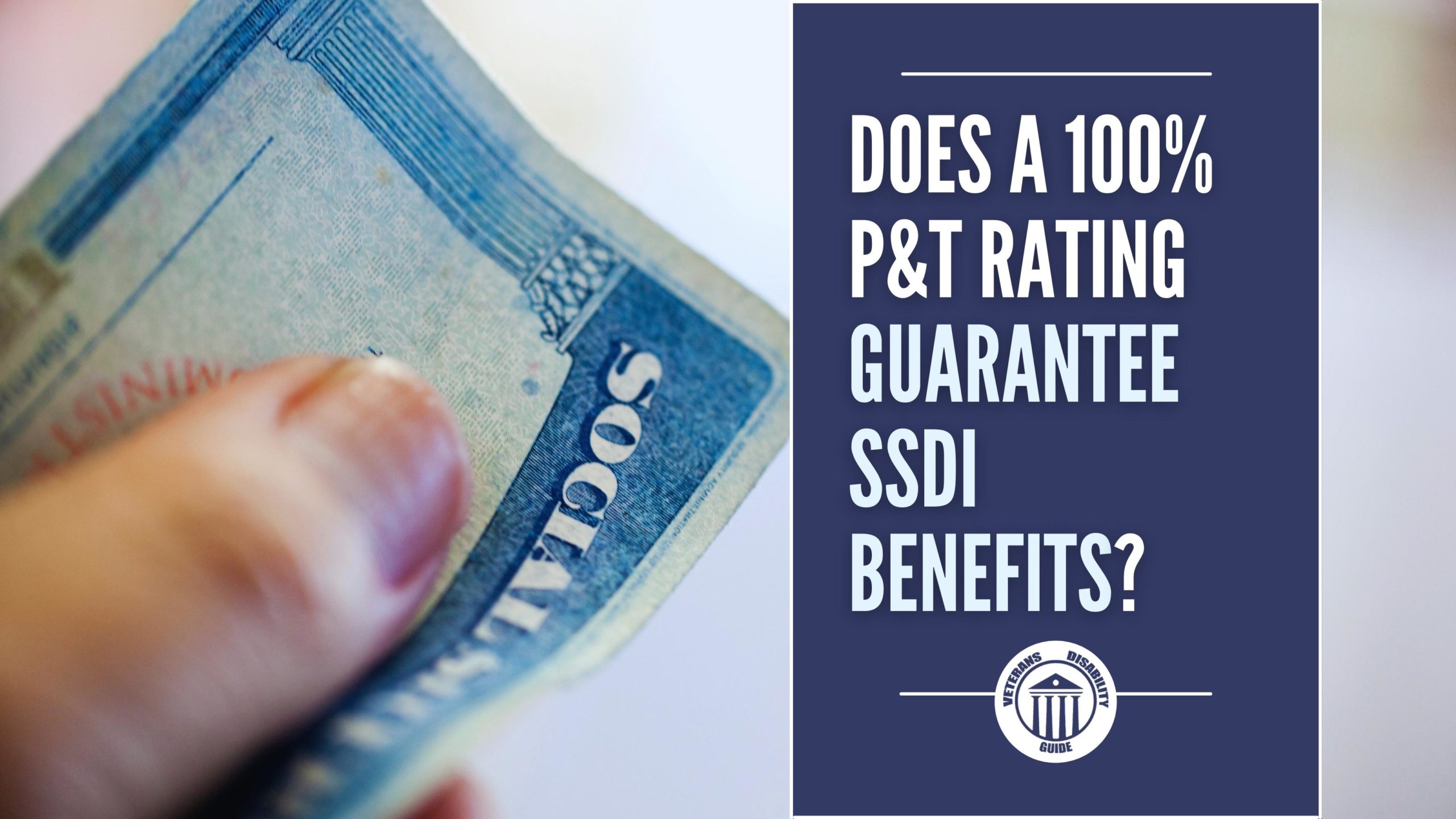
14 Jan Does a 100% P&T Rating Guarantee SSDI Benefits?
Veterans who receive a 100% Permanent and Total (P&T) rating from the VA often wonder if this means they automatically qualify for Social Security disability insurance (SSDI). Unfortunately, this rating does not guarantee that a veteran will also qualify for SSDI benefits. However, veterans who have a 100% P&T rating, and qualify for SSDI may benefit from having their claim expedited.
What Does 100% P&T Mean?
The U.S. Department of Veterans Affairs (VA) provides ratings for veterans who have service connected injuries. The ratings range from 10% to 100%, the higher percentage one has the worse their conditions, generally.
A VA disability compensation rating of 100% P&T means that your injuries are:
Permanent: The medical evidence provided shows that your condition will not improve and continue for the rest of your life.
Total: You have received a 100% rating from the VA and this rating reflects the severity of your condition.
Typically, it is easier for a veteran to receive a 100% total rating, as this is reflected in the percentage. It can be more challenging for the VA to find that your condition is severe enough to be considered permanent. Veterans who are rated at 100% P&T do not have to worry about their rating ever being revoked or reconsidered.
Those with a 100% P&T rating may also wonder if they can qualify for other disability compensation, such as SSDI. However, the differences between the VA and Social Security may prevent this from happening.
The VA Rating System VS The SSA Rating System
Much like the VA, Social Security also offers their own disability program. Their program is called Social Security disability insurance (SSDI) and it is maintained and administered by the Social Security Administration (SSA).
Despite both the VA and the SSA being federal programs, their qualification process for disability compensation is different.
What Counts as Disabled
The first major difference is how the two groups define disability. The VA provides a rating system of disability, 10% being the least and 100% being the most disabled. The SSA does not have a rating system, they either find that someone is disabled, or they are not.
Social Security’s definition of disability is: the inability to do any substantial gainful activity (SGA) by reason of any medically determinable physical or mental impairment which can be expected to result in death or which has lasted or can be expected to last for a continuous period of not less than 12 months.
1) In simple terms this means that Your disability prevents you from working above a certain limit. For 2022, the SSA determined that anyone working and earning above $1,350 per month surpasses this limit. It is important to note that the $1,350 only applies to “earned” income. Any monthly benefits earned monthly through VA disability compensation do not count towards the $1,350 as it is not considered earned income.
2) The SSA must be able to determine, with medical evidence, that your condition is severe enough to last for at least 12 months, or result in death.
SSDI Requirements
There are other factors that can impact your eligibility for SSDI benefits that are not listed in their disability definition. In addition to earning less than $1,350 per month and having medical proof that your condition is severe enough to last for at least a year, you must also have work credits.
To receive SSDI benefits, you must have also worked five out of the last ten years. During those five years you must have paid into Social Security through federal payroll tax. If you do not have sufficient work credits you will be denied, even if you meet their definition of disabled.
See: The SSDI qualifications explained
In total there is a five step qualification process that the SSA uses to determine if you are eligible to receive benefits. While this may seem like a long and tedious process, for some veterans with a 100% P&T rating who may qualify for SSDI, there are some benefits.
100% P&T Rating and SSDI Benefits
Veterans that have a 100% P&T rating from the VA and qualify for SSDI may be eligible for expedited processing of their claim.
In 2014 the SSA announced that veterans who are 100% P&T can have their SSDI claim expedited. When the SSA says they will expedite a claim it means that it is considered a high priority. A regular SSDI claim can take anywhere from three to five months to receive a decision. An expedited claim can take as little as ten days, depending on the workload the SSA has.
An expedited case does not guarantee that your claim will be approved, but it does greatly reduce the time you spend waiting for a response.
To have a claim expedited you must alert the SSA that you are a 100% P&T rated veteran. If you do not report this they will treat your paperwork like any other claim. The SSA also requires that you provide additional paperwork to prove your VA rating.
Navigating the SSDI Claims Process
If you find the many factors that are involved in qualifying and applying for SSDI benefits overwhelming, you are not alone. The process of claiming SSDI is hard to navigate. To make the process easier, many often hire legal representation. In fact, the SSA has even reported that the likelihood of winning a SSDI claim increases if you have a lawyer.
See: Why should I hire a disability lawyer to help with my SSDI claim?
Victory Disability is a nationwide law firm. We specialize in helping disabled veterans get the benefits that they have earned and deserve. Our team has helped hundreds of veterans receive extra benefits, to see if we can assist you take our free evaluation here.


